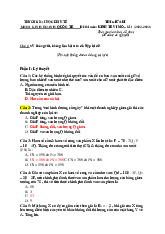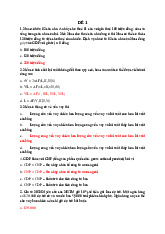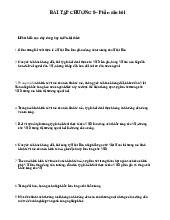



Preview text:
lOMoARcPSD| 50000674
Could Virtual Power Plants Help Stabilize the U.S. Energy Grid?
Virtual power plants amass smaller sources of electricity from different locations so they can act
as one conventional power plant. This helps balance energy grid loads and can shift power to
where it's most needed during peak times. ENERGY SYSTEMS INTEGRATION GROUP
One of the big challenges that U.S. utility companies face is that the demand for electricity isn't
constant. Instead, it goes up and down, generally dipping in the nighttime hours and rising during
the day, especially on hot days when residents are cranking up the air conditioning in their homes.
The electric companies that supply the power must be able to cope with those fluctuations and
meet the peak demand. Traditionally, that's required them either to build a lot of expensive coal,
gas or nuclear electrical generating plants, or else to buy energy from other suppliers when they need it.
But these days, some utility companies are looking at a less expensive — and potentially more
environmentally friendly — solution. We're talking about virtual power plants. 1.
What Is a Virtual Power Plant?
Virtual power plants aggregate multiple smaller sources of electricity — such as solar
panels, wind turbines and even residential storage batteries — that are distributed in different
locations across an area, so that they can act as if they are a conventional power plant, and lOMoARcPSD| 50000674
balance energy grid loads or shift power to where it's most needed for reliability. The various
units often are connected through a sophisticated software system that signals when they
need to increase or decrease power production, and directs where the energy needs to go.
In 2021, for example, Green Mountain Power, an innovative Vermont-based utility, announced a
plan to create a virtual power plant that would utilize a network of Tesla Powerwall backup
batteries in customers' homes. With the help of software from Customized Energy
Solutions (CES), the electricity stored in the Tesla batteries can be drawn back into the regional
grid system when needed to ensure a steady, regulated flow of electricity to customers. As
Cnet.com reported in March 2022, customers get a backup energy source in the event of a
power outage, while the utility gets a source of electricity that it can draw upon whenever demand peaks.
"This project would not be possible without the great partnerships we have with our customers in
the Powerwall program," Mari McClure, president and CEO of Green Mountain Power, said in a
press release. "This pilot is unique and important because it builds off our existing innovation
and collaboration to deliver meaningful change to essential grid functions by reducing carbon
emissions, increasing performance and lowering costs."
SunPower Corp., a solar technology provider, also announced in November 2021 it had launched
its own virtual power plant. The new system allows customers of Eversource and National Grid
in Massachusetts, Rhode Island and Connecticut who have SunVault storage batteries to get paid
for allowing the utilities to use their stored energy during times of peak demand.
Green Mountain Power's Frequency Regulation pays customers sharing energy through their
Tesla Powerwall batteries $13.50 per month on their energy statements. TESLA 2.
Benefits of Virtual Power Plants
In some ways, virtual power plants are analogous to grid computing systems, in which networks
of computers can share resources and even combine their capacity to perform tasks, according to
Bill Schofield. He's vice president of Future-Grid Services for CES, a Philadelphia-based firm
that provides both consulting advice and services to a variety of companies in the energy
business, including producers of solar and wind energy. One of CES' clients is Green Mountain Power.
"[Virtual power plants are] distributed ... batteries, or small, tiny power plants and local backup
generators," Schofield explains. "[It's a] very similar concept to using internet connectivity to
connect lots of little resources that can collectively do the same job as a one big power plant."
The decentralized nature of virtual power plants makes them potentially more resilient in the
wake of extreme weather or other disasters. lOMoARcPSD| 50000674
"Let's say a tornado comes through an area and knocks down the transmission line to a big power
plant. You lose all of that power. Right?" Schofield says. "But if you have a virtual power plant,
where it has lots of little resources spread all over the place, a tornado might take out 10 percent
of the virtual power plant, but the other 90 percent is still there and available."
Virtual power plants are advantageous for grids in other ways as well, including voltage support.
A crucial factor in a reliable electric grid is keeping voltage within acceptable levels; otherwise,
equipment can be damaged, there could be power outages, etc. But voltage varies across the grid
and at each interface (substations, transformers, etc.), the correct voltage has to be maintained.
With a virtual power plant, there are fewer of these. "You have lots of little resources located
close to or at the same location to where the electricity is being used," Schofield explains. "You
don't have to build as big of a distribution or transmission lines in order to maintain the correct voltage."
If a tornado takes out a transmission line to a major power plant, the area could lose all of its
electricity. But not with a virtual power plant. 3.
Renewable Energy Is Key
Yet another advantage of virtual power plants is that they make it easier to regulate renewable
energy sources and to get the sort of control over the amount of electricity going into the grid
that a conventional fossil-fuel-burning electrical plant would have.
"A virtual power plant can include, again, little batteries for backup generator, but it can also
under the general term, include what's called 'demand response,'" Schofield says.
A utility with a virtual power plant can send messages to customers to turn down their usage at
certain times, possibly offering a gift certificate for a local restaurant as an incentive. In parts of
the country where utilities buy electricity from various suppliers, virtual power plants could help
utility companies be responsive to the market price for electricity.
Indirectly, those incentives can help facilitate renewable energy sources like wind and solar,
Schofield says. Because they're variable — meaning the sun stops shining and the wind stops
blowing — the amount of electricity they provide must be adjusted to the ability they can
accommodate. Traditionally, the balance is offset by fossil fuel providers.
"A virtual power plant is intended to function the same, or to provide the same sort of services
that a big power plant can," Schofield says, "and to be dispatchable, meaning I can communicate
to it and tell it to do something different. The ramp up or down is part of the value."
By interacting with consumers and recruiting them to help with managing energy use, virtual
power plants could play a role in solving one of the utility industry's longtime problems: peak usage. lOMoARcPSD| 50000674
"A significant majority of the cost of providing electricity is just to handle those peak days,"
Schofield says. "If you can get consumers of all types to use their consumption in those ways,
maybe brush their teeth with a regular toothbrush instead of their electric ... then you can take out
a lot of cost from the system. And you can also take out a lot of need for burning fossil fuels. But
this is historically very difficult, because ... the average person isn't going to inconvenience themselves very much."
But he also says that's changing. Younger generations are more sustainably conscious, and
everyone has a smartphone. Perhaps one day you'll get an alert on your phone that says "Electric
usage alert. Please turn down your thermostat." And you'll earn incentive points if you do it. Would you?
Schofield says you might. "Mostly people want to do a good thing because actually they're
paying a fixed price, and the actual cost to them of consuming that electricity is pretty small," he
says. "But if you get thousands of people all responding, then that little bit adds up to something meaningful."




